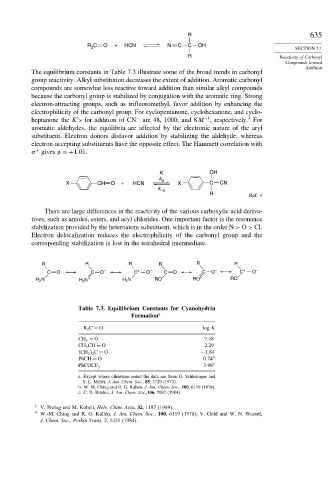Page 653 - Advanced Organic Chemistry Part A - Structure and Mechanisms, 5th ed (2007) - Carey _ Sundberg
P. 653
R 635
R C O + HCN N C C OH SECTION 7.1
2
R Reactivity of Carbonyl
Compounds toward
Addition
The equilibrium constants in Table 7.3 illustrate some of the broad trends in carbonyl
group reactivity. Alkyl substitution decreases the extent of addition. Aromatic carbonyl
compounds are somewhat less reactive toward addition than similar alkyl compounds
because the carbonyl group is stabilized by conjugation with the aromatic ring. Strong
electron-attracting groups, such as trifluoromethyl, favor addition by enhancing the
electrophilicity of the carbonyl group. For cyclopentanone, cyclohexanone, and cyclo-
−1
3
heptanone the K’s for addition of CN are 48, 1000, and 8M , respectively. For
−
aromatic aldehydes, the equilibria are affected by the electronic nature of the aryl
substituent. Electron donors disfavor addition by stabilizing the aldehyde, whereas
electron-accepting substituents have the opposite effect. The Hammett correlation with
gives =+1 01.
+
K OH
k a
X CH O + HCN X C CN
k –a
H Ref. 4
There are large differences in the reactivity of the various carboxylic acid deriva-
tives, such as amides, esters, and acyl chlorides. One important factor is the resonance
stabilization provided by the heteroatom substituent, which is in the order N > O > Cl.
Electron delocalization reduces the electrophilicity of the carbonyl group and the
corresponding stabilization is lost in the tetrahedral intermediate.
R R R R R R
C O C O – C + O – C O C O – C + O –
H 2 N H 2 N + H 2 N RO RO + RO
Table 7.3. Equilibrium Constants for Cyanohydrin
Formation a
R 2 C = O log K
CH 2 = O 7.48
CH 3 CH = O 2.29
CH 3 2 C = O −1 84
PhCH = O 0 74 b
3 98 c
PhCOCF 3
a. Except where otherwise noted the data are from G. Schlesinger and
S. L. Miller, J. Am. Chem. Soc., 85, 3729 (1973).
b. W. M. Ching and R. G. Kallen, J. Am. Chem. Soc., 100, 6119 (1978).
c. C. D. Ritchie, J. Am. Chem. Soc.,106, 7087 (1984).
3 V. Prelog and M. Kobelt, Helv. Chim. Acta, 32, 1187 (1949).
4
W.-M. Ching and R. G. Kallen, J. Am. Chem. Soc., 100, 6119 (1978); V. Gold and W. N. Wassef,
J. Chem. Soc., Perkin Trans. 2, 1431 (1984).

